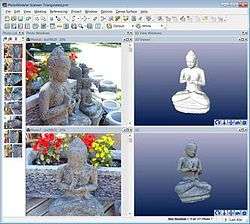PhotoModeler
PhotoModeler is a software application that performs image-based modeling and close range stereophotogrammetry – producing 3D models and measurements from photography. The software is used for close-range, aerial and uav photogrammetry.
 Screenshot of PhotoModeler | |
| Developer(s) | Eos Systems Inc. |
|---|---|
| Initial release | 1994 |
| Operating system | Microsoft Windows |
| Type | Photogrammetry |
| License | Proprietary commercial software |
| Website | www |
Close Range Photogrammetry (CRP) can mean photographs taken from the ground with a handheld camera, or taken from a UAV/drone at relatively low altitude. PhotoModeler and CRP are used for performing measurement and modeling in agriculture, archaeology, architecture, biology, engineering, fabrication, film production, forensics, mining, stockpile volumes, etc.[1][2][3]
Applications
Some of the applications of PhotoModeler are:
- Accident reconstruction / Forensics[4]
- Archaeology / Paleontology[5]
- Architecture
- Biology[6][7]
- Engineering[8][9]
- Fabrication and Manufacturing
- Film[10]
- Mining[11]
- Situational Awareness (SA)[12]
gollark: In constant unending streams of lagginess.
gollark: With a kinetic augment, you can make *turtles* fire shurikens. But with no control over direction (they go straight in the direction it's pointing).
gollark: One embossment per tool.
gollark: Nope!
gollark: 5 Reinforceds and your tool takes no damage at all ever. Manyullyn blades + embossed paper gives you 6 modifiers, so use one for sharpness or something and you can do something like 7 damage per shot.
See also
Notes and references
- Luhman 2006: p.469
- Karara 1989: p.321
- McGlone 2004: p.1015
- The Boston Channel 2008
- Matthews 2008: p. 11
- Bythell 2011
- de Bruyn 2009
- Grande 2006
- Richardson 2008
- Duesing 2006
- Dunn 2009
- Schwartz
Notes
- Atkinson, K.B. (1996). Close Range Photogrammetry and Machine Vision. Latheronwheel, Scotland: Whittles Publishing. ISBN 1-870325-46-X.
- Bythell, J.; Pan, P. "Three-dimensional morphometric measurements of reef corals using underwater photogrammetry techniques". Coral Reefs. SpringerLink. 20 (3): 193–199. doi:10.1007/s003380100157. Archived from the original on 2013-01-28. Retrieved 31 May 2011.
- de Bruyn, P.J.N.; Bester, M.N.; Carlini, A.R.; Oosthuizen, W.C. (2009). "How to weigh an elephant seal with one finger: a simple three-dimensional photogrammetric application". Aquatic Biology. 5: 31–39. doi:10.3354/ab00135.
- Dunn, Maynard (2009). "RECENT DEVELOPMENTS IN CLOSE RANGE PHOTOGRAMMETRY FOR MINING AND RECLAMATION" (pdf). Retrieved 31 May 2011.
- Duesing, Brett (2006). "Q&A: Pushing Visual Limits of 3D". Cadalyst Magazine. Retrieved 31 May 2011.
- Grande, Joseph (July 2006). "3D Part Inspection Is a Snapshot Away". Plastics Technology. Retrieved 31 May 2011.
- Karara, H.M. (1989). Non-Topographic Photogrammetry (2nd ed.). Falls Church, VA, USA: American Society for Photogrammetry and Remote Sensing. ISBN 0-944426-10-7.
- Luhmann, Thomas; Robson; Kyle; Harley (2006). Close Range Photogrammetry: Principles, Methods and Applications. Dunbeath,Scotland: Whittles Publishing. ISBN 1-870325-50-8.
- Matthews, N. A. (2008). "Aerial and Close-Range Photogrammetric Technology: Providing Resource Documentation, Interpretation, and Preservation" (pdf). Denver, Colorado: U.S. Department of the Interior, Bureau of Land Management, National Operations Center. p. 42. Retrieved 31 May 2011.
- McGlone, Chris (2004). Manual of Photogrammetry (5th ed.). Bethesda, MA, USA: American Society for Photogrammetry and Remote Sensing. ISBN 1-57083-071-1.
- Richardson, Shawn (2008). "Using Photo Modeling to Obtain the Modes of a Structure" (pdf). Sound and Vibration. Retrieved 31 May 2011.
- "Police Take Accident Reconstruction To Skies: Photogrammetry Animation Can Be Used In Court". The Boston Channel. 2008. Retrieved 31 May 2011.
- Schwartz, J. "Precise positioning surveillance in 3-D using night-vision stereoscopic photogrammetry". Display Technologies and Applications for Defense, Security, and Avionics - V. S.P.I.E. 8042. doi:10.1117/12.884597. Retrieved 20 December 2011.
This article is issued from Wikipedia. The text is licensed under Creative Commons - Attribution - Sharealike. Additional terms may apply for the media files.